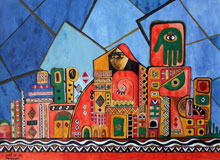The arrival of the seventh annual Art Dubai fair this week brings together over US$40 million worth of art from the region, bringing into focus again both the interest in defining what is contemporary Arab art, and the number of collectors looking to add the oeuvre of regional artists to their holdings.
Additionally, Alhoush.com is a new online platform for artists in the Middle East to showcase and sell their work and make a living. Established by Ehab Shanti and Rashid Abdelhamid, Alhoush is an amalgamation of the arts and commerce: designed to help alleviate the job scarcity in the region and a void of modern Arab-inspired art.
An edited transcript of the conversation follows.
Arabic Knowledge at Wharton: What compelled you to form Alhoush? Did you find that the art scene was being overlooked or was relegated to a certain group in society?
Ehab Shanti and Rashid Abdelhamid: We are passionate about art and design and believe that it can play a profound role in overcoming the challenges facing our part of the world. So, we decided to create Alhoush to serve as a common space that empowers artists and designers from across the region.
We often would research a particular artist or item and would find it hard to find any information. So we identified a clear gap and decided to fill it, and Alhoush was born. Not only do we showcase the artists and designers, but also we help them sell their works and connect with art and design lovers around the world.
Arabic Knowledge at Wharton: Was it difficult to gather momentum for the organization and get investors or raise the initial capital needed?
Shanti and Abdelhamid: We spent a good year of hard work to build the site and to register the first batch of artists and reach out to sponsors and investors. Not only did we need to convince the artists and designers that Alhoush would be good for them, but we also had to convince the sponsors that we are somehow helping fulfill their mission, and the investors that we are building a viable business.
So it took us one year to get 120 skeptical artists and designers registered before the launch of the site. But right after the site was officially launched we got more than 250 artists and designers from across the region in four months, who have joined Alhoush organically, and the site is establishing itself as the premier portal for art and design from the Arab world.
Of course we could not have done any of this, and we would not have been as successful in reaching so far without the support of organizations such as UNESCO, and an angel investor (Fadi Ghandour of MENA Ventures) who took a big risk and funded us with the essential seed.
Access to funding remains embryonic in the Middle East. There are some amazing individuals who understand the benefits and risks of investing in start-ups. Conversely, a majority of investors in the region just do not get it yet. They are committed to bricks and mortar rather than ideas, which in fact in many cases offer clumsy returns compared with knowledge or service-based companies that succeed.
Arabic Knowledge at Wharton: How can art and design create jobs? Does it have the power to create a strong economic impact in addition to a social one?
Shanti and Abdelhamid: We firmly believe that art and design and the creative economy can play a central role in overcoming the challenges facing our region.
For instance, when you buy an item from one young or established jewelry designers on our portal, you are not only supporting that one individual, but a small economy that belies their operation — of craftspeople, packagers, IT, shippers etc. If you look at countries in Europe like Spain, France, Italy, or Denmark, a great chunk of their economic output comes from innovation and creative industries such as fashion or art.
So, it is a little coincidence that on the list of the wealthiest people from around the world, the owners of fashion houses such as Amancio Ortega of Inditex are on the very top. For instance if you look at houses like LVMH in France, not only does it have a valuation of US$98 billion, but it employs over 100,000.
We are not naïve in thinking we are going to create the next Louis Vuitton, but who knows which one of our artists and designers can become a global brand, especially when the barriers to entry nowadays have become very small.
So, not only does design and art make life more beautiful to live, but we firmly believe that they can play a central role in the Arab world’s greatest challenge: to create a hundred million jobs in the upcoming ten years. This is our agenda, and we will not shy from advocating it.
Arabic Knowledge at Wharton: How would you describe the current art scene in the MENA region? Is it stifled or vibrant?
Shanti and Abdelhamid: Vibrant! We are awe-struck on a daily basis by the incredible talents that are out there, who receive little to no attention. The global satellite channels are so focused on the political turmoil of the region, that they are giving a deformed or incomplete picture about the region. Part of our mission is to tell this story of the incredible treasure of creativity that we meet every day.
Yet, while there is no shortage of creativity, there is not the ethos or environment that can nurture it so that it realizes its full potential and serve as a central pillar in building the foundations for a better region.



